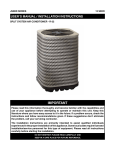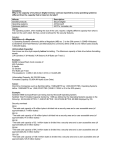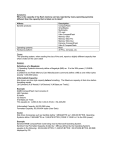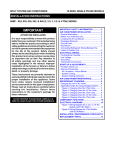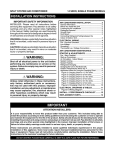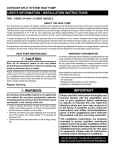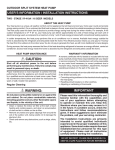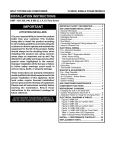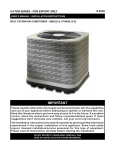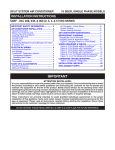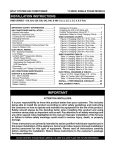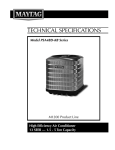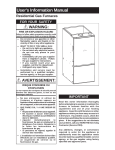Download Kelvinator JS4BE-048KA Installation Guide
Transcript
Split system air conditioner 14 SEER, Single Phase Models Installation Instructions *S4BE - 018KB, 024KB, 030KB, 036KB (1.5, 2, 2.5, & 3 Ton) Series IMPORTANT ATTENTION INSTALLERS: It is your responsibility to know this product better than your customer.This includes being able to install the product according to strict safety guidelines and instructing the customer on how to operate and maintain the equipment for the life of the product. Safety should always be the deciding factor when installing this product and using common sense plays an important role as well. Pay attention to all safety warnings and any other special notes highlighted in the manual. Improper installation of the furnace or failure to follow safety warnings could result in serious injury, death, or property damage. These instructions are primarily intended to assist qualified individuals experienced in the proper installation of this appliance. Some local codes require licensed installation/ service personnel for this type of equipment. Please read all instructions carefully before starting the installation. Return these instructions to the customer’s package for future reference. DO NOT DESTROY. PLEASE READ CAREFULLY & KEEP IN A SAFE PLACE FOR FUTURE REFERENCE. important SAFETY INFORMATION....................... 2 Air conditioner INSTallATION.......................... 3 General Information.................................................... 3 Before You Install this Unit......................................... 3 Locating the Air Conditioner....................................... 3 Packaging Removal.................................................... 3 Ground Level.............................................................. 3 Roof Mount................................................................. 3 ELECTRICAL WIRING................................................. 4 Pre-Electrical Checklist.............................................. 4 Line Voltage................................................................ 4 Connecting Refrigerant Tubing Between the Indoor & Outdoor Unit................................................ 4 Grounding................................................................... 5 Thermostat Connections............................................ 5 START UP & ADJUSTMENTS.................................... 5 Pre-Start Check List................................................... 5 Start-Up Procedures................................................... 5 Air Circulation - Indoor Blower.................................. 5 System Cooling........................................................ 5 System Heating (optional)........................................ 6 Air conditioner MAINTENANCE.......................... 6 Refrigerant Charging....................................... 6 Charging the Unit in AC mode.................................... 7 Charging Charts & Application Notes........................ 7 Figure 2. Charging Chart (1.5 Ton Models).............. 8 Figure 3. Charging Chart (2 Ton Models)................. 8 Figure 4. Charging Chart (2.5 Ton Models).............. 9 Figure 5. Charging Chart (3 Ton Models)................. 9 Table 3. Charging Table (1.5 Ton Units).................... 10 Table 4. Charging Table (2 Ton Units)....................... 10 Table 5. Charging Table (2.5 Ton Units).................... 11 Table 6. Charging Table (3Ton Units)........................ 11 Wiring Diagrams.................................................... 12 Figure 6. W.D. for 1.5, 2, 2.5, & 3 Ton Models........... 12 Figure 7. W.D. for 3 Ton Models................................ 13 INSTALLATION / PERFORMANCE CHECKLIST....... 16 REPLACEMENT PARTS.............................................. 16 important SAFETY INFORMATION INSTALLER: Please read all instructions before servicing this equipment. Pay attention to all safety warnings and any other special notes highlighted in the manual. Safety markings are used frequently throughout this manual to designate a degree or level of seriousness and should not be ignored. WARNING indicates a potentially hazardous situation that if not avoided, could result in personal injury or death. CAUTION indicates a potentially hazardous situation that if not avoided, may result in minor or moderate injury or property damage. WARNING: Shut off all electrical power to the unit before performing any maintenance or service on the system. Failure to comply may result in personal injury or death. WARNING: Unless noted otherwise in these instructions, only factory authorized parts or accessory kits may be used with this product. Improper installation, service, adjustment, or maintenance may cause explosion, fire, electrical shock or other hazardous conditions which may result in personal injury or property damage WARNING: S4BE Split System Air Conditioners are shipped charged with R410A refrigerant and ready for installation. If repairs make it necessary for evacuation and charging, it should only be attempted by qualified trained personnel thoroughly familiar with this equipment. Under no circumstances should the owner attempt to install and/or service this equipment. Failure to comply with this warning could result in property damage, personal injury, or death. CAUTION: This unit uses refrigerant R-410A. DO NOT use any other refrigerant in this unit. Use of another refrigerant will damage the unit. 2 WARNING: The information listed below must be followed during the installation, service, and operation of this unit. Unqualified individuals should not attempt to interpret these instructions or install this equipment. Failure to follow safety recommendations could result in possible damage to the equipment, serious personal injury or death. • The installer must comply with all local codes and regulations which govern the installation of this type of equipment. Local codes and regulations take precedence over any recommendations contained in these instructions. Consult local building codes and the National Electrical Code (ANSI CI) for special installation requirements. • All electrical wiring must be completed in accordance with local, state and national codes and regulations and with the National Electric Code (ANSI/NFPA 70) or in Canada the Canadian Electric Code Part 1 CSA C.22.1. • This equipment contains liquid and gaseous refrigerant under high pressure. DO NOT USE ANY PORTION OF THE CHARGE FOR PURGING OR LEAK TESTING. Installation or servicing should only be performed by qualified trained personnel thoroughly familiar with this type equipment. • Fully annealed, refrigerant grade copper tubing should be used when installing the system. Refrigerant suction line tubing should be fully insulated. • Installation of equipment may require brazing operations. Installer must comply with safety codes and wear appropriate safety equipment (safety glasses, work gloves, fire extinguisher, etc.) when performing brazing operations. • Follow all precautions in the literature, on tags, and on labels provided with the equipment. Read and thoroughly understand the instructions provided with the equipment prior to performing the installation and operational checkout of the equipment. • Refrigerant and electrical line should be routed through suitably waterproofed openings to prevent water from leaking into the structure. Air conditioner INSTallATION General Information The S4BE series air conditioner is designed only for outdoor rooftop or ground level installations. This unit has been tested for capacity and efficiency in accordance with AHRI Standards and will provide many years of safe and dependable comfort, providing it is properly installed and maintained. Abuse, improper use, and/or improper maintenance can shorten the life of the appliance and create unsafe hazards. To achieve optimum performance and minimize equipment failure, it is recommended that periodic maintenance be performed on this unit. The ability to properly perform maintenance on this equipment requires certain mechanical skills and tools. Before You Install this Unit √ The cooling load of the area to be conditioned must be calculated and a system of the proper capacity selected. It is recommended that the area to be conditioned be completely insulated and vapor sealed. √ Check the electrical supply and verify the power supply is adequate for unit operation. The system must be wired and provided with circuit protection in accordance with local building codes. If there is any question concerning the power supply, contact the local power company. √ The indoor section (air handler, furnace, etc) should be installed before routing the refrigerant tubing. Refer to the indoor unit's installation instructions for installation details. √ All units are securely packed at the time of shipment and upon arrival should be carefully inspected for damage prior to installing the equipment at the job site. Verify coil fins are straight. If necessary, comb fins to remove flattened or bent fins. Claims for damage (apparent or concealed) should be filed immediately with the carrier. √ Please consult your dealer for maintenance information and availability of maintenance contracts. Please read all instructions before installing the unit. Locating the Air Conditioner • Survey the job site to determine the best location for mounting the outdoor unit. • Sufficient clearance for unobstructed airflow through the outdoor coil must be maintained in order to achieve rated performance. See Figure 1 for minimum clearances to obstructions. • Overhead obstructions (Figure 1), poorly ventilated areas, and areas subject to accumulation of debris should be avoided. • Consideration should be given to availability of electric power, service access, noise, and shade. Packaging Removal NOTE: To prevent damage to the tubing connections, carefully remove the carton and user’s manual from the equipment. Discard the shipping carton. Ground Level Ground level installations must be located according to local building codes or ordinances and these requirements: • Clearances must be in accordance with those shown in Figure 1. • A suitable mounting pad (Figure 1) must be provided and separate from the building foundation. The pad must be level and strong enough to support the weight of the unit. The slab height must be a minimum of 2” (5 cm) above grade and with adequate drainage. Roof Mount • The method of mounting should be designed so that it does not overload roof structures or transmit noise to the interior of the structure. The roof must be structurally capable of handling the weight of the unit. • Full perimeter support is required under the unit. Support must be made of weather resistant materials and installed prior to unit installation. • The support must be built to raise the unit 6" above the roof. 6” from Building or Structure 24" for Service Access 12" or 18” See Note DO NOT OBSTRUCT TOP OF UNIT 12" or 18” See Note NOTE: Units require full perimeter clearances. Installer must maintain 18” between two units or 12” between single unit and structure. 48” 2” Mounting Pad Figure 1. Clearance Requirements 3 Connecting Refrigerant Tubing Between the Indoor & Outdoor Unit CAUTION: ELECTRICAL WIRING WARNING: ELECTRICAL SHOCK OR FIRE HAZARD When servicing, cover or seal openings to minimize the exposure of the refrigerant system to air to prevent accumulation of moisture and other contaminants. To avoid risk of electrical shock, personal injury, or death, disconnect all electrical power to the unit before performing any maintenance or service. The unit may have more than one electrical supply. After outdoor and indoor unit placement has been determined, route refrigerant tubing between the equipment in accordance with sound installation practices. Label all wires prior to disconnection when servicing the unit. Wiring errors can cause improper and dangerous operation. • When connecting refrigerant linesets together, it is recommended that dry nitrogen be flowing through the joints during brazing to prevent internal oxidation and scaling. • Refrigerant tubing should be routed in a manner that minimizes the length of tubing and the number of bends in the tubing. If precise forming of refrigerant lines is required, a copper tubing bender is recommended. Avoid sharp bends and contact of the refrigerant lines with metal surfaces. • Refrigerant tubing should be supported in a manner that the tubing will not vibrate or abrade during system operation. • Tubing should be kept clean of foreign debris during installation. • Every effort should be made by the installer to ensure that the field installed refrigerant containing components of the system have been installed in accordance with these instructions and sound installation practices to insure reliable system operation and longevity. • The maximum recommended interconnecting refrigerant line lengths is 75 ft. and the vertical elevation difference between the indoor and outdoor sections should not exceed 20 ft. NOTE: For installations exceeding these conditions, please refer to the Application Guidelines for Refrigerant Lines Addendum. • A filter dryer is provided with the unit and must be installed in the liquid line of the system. If the installation replaces a system with a filter dryer already present in the liquid line, the filter dryer must be replaced with the one supplied with the unit. The filter dryer must be installed in strict accordance with the manufacturer’s installation instructions. • Optional equipment such as liquid line solenoid valves, low ambient, etc., should be installed in strict accordance with the manufacturer’s installation instructions. 4 • All electrical connections must be in compliance with all applicable local codes and ordinances, and with the current revision of the National Electric Code (ANSI/NFPA 70). • For Canadian installations the electrical connections and grounding shall comply with the current Canadian Electrical Code (CSA C22.1 and/or local codes). Pre-Electrical Checklist √Verify that the voltage, frequency, and phase of the supply source match the specifications on the unit rating plate. √ Verify that the service provided by the utility is sufficient to handle the additional load imposed by this equipment. Refer to the unit wiring label for proper voltage wiring. √ Verify factory wiring is in accordance with the unit wiring diagram. See Figure 6, (page 12) and Figure 7, (page 13). Inspect for loose connections. Line Voltage • A wiring diagram is located on the inside cover of the electrical box of the outdoor unit. The installer should become familiar with the wiring diagram before making any electrical connections to the outdoor unit. • An electrical disconnect must be located within sight of and readily accessible to the unit. This switch shall be capable of electrically de-energizing the outdoor unit. • Line voltage to the unit should be supplied from a dedicated branch circuit containing the correct fuse or circuit breaker for the unit. Incoming field wiring and minimum size of electrical conductors and circuit protection must be in compliance with information listed on the outdoor unit data label. Any other wiring methods must be acceptable to authority having jurisdiction. • The outdoor unit requires both power and control circuit electrical connections. Refer to the wiring diagram / schematic for identification and location of outdoor unit field wiring interfaces. See Figure 6. and Figure 7. Make all electrical connections in accordance with all applicable codes and ordinances. • Overcurrent protection must be provided at the branch circuit distribution panel and sized as shown on the unit rating label and according to applicable local codes. See the unit rating plate for minimum circuit ampacity and maximum overcurrent protection limits. • Provide power supply for the unit in accordance with the unit wiring diagram, and the unit rating plate. Connect the line-voltage leads to the terminals on the contactor inside the control compartment. • Use only copper wire for the line voltage power supply to this unit as listed in Table 1. Use proper code agency listed conduit and a conduit connector for connecting the supply wires to the unit. Use of rain tight conduit is recommended. • 208/230 Volt units are shipped from the factory wired for 230 volt operation. For 208V operation, remove the lead from the transformer terminal marked 240V and connect it to the terminal marked 208V. • Optional equipment requiring connection to the power or control circuits must be wired in strict accordance of the NEC (ANSI/NFPA 70), applicable local codes, and the instructions provided with the equipment. Grounding WARNING: The unit cabinet must have an uninterrupted or unbroken electrical ground to minimize personal injury if an electrical fault should occur. Do not use gas piping as an electrical ground! This unit must be electrically grounded in accordance with local codes or, in the absence of local codes, with the National Electrical Code (ANSI/NFPA 70) or the CSA C22.1 Electrical Code. Use the grounding lug provided in the control box for grounding the unit. COPPER WIRE SIZE — AWG (1% Voltage Drop) Supply Wire Length-Feet 200 150 100 50 6 4 4 4 3 3 2 2 2 1 8 6 6 4 4 4 3 3 3 2 10 8 8 6 6 6 4 4 4 3 14 12 10 10 8 8 6 6 6 4 Supply Circuit Ampacity 15 20 25 30 35 40 45 50 55 60 Wire Size based on N.E.C. for 60° type copper conductors. Table 1. Copper Wire Size Thermostat Wire Gauge Maximum Recommended Thermostat Wire Length (FT) 24 25 22 45 20 70 18 110 Table 2. Thermostat Wire Gauge Thermostat Connections • Thermostat connections should be made in accordance with the instructions supplied with the thermostat and the indoor equipment. • The outdoor unit is designed to operate from a 24 VAC Class II control circuit. The control circuit wiring must comply with the current provisions of the NEC (ANSI/ NFPA 70) and with applicable local codes having jurisdiction. • The low voltage wires must be properly connected to the units low voltage terminal block. Recommended wire gauge and wire lengths for typical thermostat connections are listed in Table 2. • The thermostat should be mounted about 5 feet above the floor on an inside wall. DO NOT install the thermostat on an outside wall or any other location where its operation may be adversely affected by radiant heat from fireplaces, sunlight, or lighting fixtures, and convective heat from warm air registers or electrical appliances. Refer to the thermostat manufacturer’s instruction sheet for detailed mounting and installation information. START UP & ADJUSTMENTS Pre-Start Check List √Verify the indoor unit is level and allows proper condensate drainage. √Verify the outdoor coil and top of the unit are free from obstructions and debris, and all equipment access/ control panels are in place. √Verify air filters are cleaned and properly installed. √Verify duct work is sealed to prevent air leakage. √ Verify line voltage power leads are securely connected and the unit is properly grounded. √ Verify low voltage wires are securely connected to the correct leads on the low voltage terminal strip. √ Verify power supply branch circuit overcurrent protection is sized properly. √Verify the thermostat is wired correctly. Start-Up Procedures The thermostat's function mode should be set to OFF and the fan mode should be set to AUTO. Close all electrical disconnects to energize the system. Air Circulation - Indoor Blower 1.Set the thermostat system mode on OFF and the fan mode to ON. 2.Verify the blower runs continuously. Check the air delivery at the supply registers and adjust register openings for balanced air distribution. If insufficient air is detected, examine ductwork for leaks or obstructions. 3.Set the thermostat fan mode to AUTO and verify the blower stops running. System Cooling 1.Set the thermostat’s system mode to COOL and the fan mode to AUTO. Gradually lower the thermostat temperature setpoint below room temperature and verify the outdoor unit and indoor blower energize. 5 2.Verify blower wheel is spinning in direction indicated by arrow. Feel the air being circulated by the indoor blower and verify that it is cooler than ambient temperature. Listen for any unusual noises. If unusual sounds occur, determine the source of the noise and correct as necessary. 3.Verify HI and LO refrigerant pressures. 4.Allow the system to operate for several minutes and then set the temperature selector above room temperature. Verify the fan and compressor cycle off with the thermostat. NOTE: The blower should also stop unless fan mode is set to the ON position. System Heating (optional) 1.Set the thermostat's system mode to HEAT and the temperature mode above room temperature. 2.Verify the optional heating equipment (furnace or electric heat) and indoor blower energize. Feel the air being circulated by the indoor blower and verify that it is warmer than ambient temperature. Listen for any unusual noises. If unusual sounds occur, determine the source of the noise and correct as necessary. Air conditioner MAINTENANCE WARNING: To prevent electrical shock, personal injury, or death, disconnect all electrical power to the unit before performing any maintenance or service. The unit may have more than one electrical supply. Proper maintenance is important to achieve optimum performance from the air conditioner. The ability to properly perform maintenance on this equipment requires certain mechanical skills and tools. If you do not possess these skills, contact your dealer for maintenance. Consult your local dealer about the availability of maintenance contracts. Routine maintenance should include the following: • Inspect and clean or replace air filters at the beginning of each heating and cooling season, or more frequently if required. • Inspect the condensate drain and outdoor coil at the beginning of each cooling season. Remove any debris. Clean the outdoor coil and louvers as necessary using a mild detergent and water. Rinse thoroughly with water. • Inspect the electrical connections for tightness at the beginning of each heating and cooling season. Service as necessary. CAUTION: The unit should never be operated without a filter in the return air system. Replace disposable filters with the same type and size. • Do not attempt to add additional oil to motors unequipped with oil tubes. The compressor is hermetically sealed at the factory and does not require lubrication. 6 Refrigerant Charging WARNING: S4BE Split System Air Conditioners are shipped charged with R410A refrigerant and ready for installation. If repairs make it necessary for evacuation and charging, it should only be attempted by qualified trained personnel thoroughly familiar with this equipment. Under no circumstances should the owner attempt to install and/or service this equipment. Failure to comply with this warning could result in property damage, personal injury, or death. After refrigerant line connections are completed, it is required that you leak check and evacuate the indoor section and all line connections (using proper methods) before finalizing the full system refrigerant charge. • S4BE outdoor units with non-AHRI listed indoor coils are not recommended. Deviations from rated airflows or non-listed combinations may require modification to the expansion device and refrigerant charging procedures for proper and efficient system operation. Refer to Table 3, (page 10), Table 4, (page 10), Table 5, (page 11), or Table 6, (page 11) to determine the ideal amount of sub-cooling for a given liquid pressure. • The refrigerant charge can be checked and adjusted through the service ports provided external to the outdoor unit. Use only gage line sets which have a “Schrader” depression device present to actuate the valve. • A high-pressure switch is factory-installed and located in the liquid line internal to the outdoor unit. The switch is designed to protect the system when very high pressures occur during abnormal conditions. Under normal conditions, the switch is closed. If the liquid pressure rises above 575 psig, then the switch will open and de-energize the outdoor unit. The switch will close again once the liquid pressure decreases to 460 psig. Please note that the switch interrupts the thermostat inputs to the unit. Thus, when the switch opens and then closes, there may be a 5 minute short cycling delay before the outdoor unit will energize. • A low-pressure switch (select models only) is factoryinstalled and located in the suction line internal to the outdoor unit. The switch is designed to protect the compressor from a loss of charge. Under normal conditions, the switch is closed. If the suction pressure falls below 5 psig, then the switch will open and deenergize the outdoor unit. The switch will close again once the suction pressure increases above 20 psig. Please note that the switch interrupts the thermostat inputs to the unit. When the switch opens and then closes, there will be a 5 minute short cycling delay before the outdoor unit will energize. Charging the Unit in AC mode (At outdoor temperatures above 55° F for optimized sub-cooling of 10° F - 12° F.) 1.With the system operating at steady-state, measure the liquid refrigerant pressure (in psig) at the outdoor unit service valve. 2.Measure the liquid refrigerant temperature (in Fahrenheit) at the service valve. 3.Determine the required liquid refrigerant pressure from Table 3, (page 10), Table 4, (page 10), Table 5, (page 11), or Table 6, (page 11). • If the pressure measured in Step 1 is greater than the required liquid refrigerant pressure determined in Step 3, then there is too much charge in the system. Remove refrigerant and repeat Steps 1 through 3 until the system is correctly charged. • If the pressure measured in Step 1 is less than the required liquid refrigerant pressure determined in Step 3, there is too little charge in the system. Add refrigerant and repeat Steps 1 through 3 until the system is correctly charged. Charging Charts & Application Notes • This equipment’s cooling system contains refrigerant under high pressure. Always use safe and environmentally sound methods when handling refrigerant handling or servicing the unit. Review the factory literature and safety warnings prior to servicing. • When repairing system leaks, always use a nitrogen (inert) gas to protect the refrigerant system and pressure check the repair before re-charging. Always replace the filter-dryers when performing any repair to the refrigeration system with one capable of acid removal. After completing the repairs, evacuate the system to 350 - 500 microns and weigh in the refrigerant to the amount specified on the unit rating label. • The refrigerant charging charts Figure 2, (page 8), Figure 3, (page 8), Figure 4, (page 9), & Figure 5, (page 9) are applicable only to matched assemblies of NORDYNE equipment and listed airflows for the indoor coil. NOTE: Before using these charts, make sure the unit is in a stable operating mode. As shown in the charts, the ideal system sub-cooling can vary over the range of operation. Reference the charts to determine the ideal amount of sub-cooling for a given liquid pressure. Units charged to other values will not perform at the rated unit efficiency (EER) or rated Coefficient of Performance (COP) in heating mode. • Table 3, (page 10), Table 4, (page 10), Table 5, (page 11), or Table 6, (page 11) are valid for a variety of indoor, return air conditions and are most influenced by the outdoor ambient temperature, outdoor fan operation and the unit operating voltage. Before using these tables, make sure the unit is in a stable operating mode. The ideal system sub-cooling can vary over the range of operation. Reference the tables to determine the ideal amount of sub-cooling for a given liquid pressure. Units charged to other values will not perform at the rated unit efficiency (EER) or rated Coefficient of Performance (COP) in heating mode. • To inspect a systems operation using quality instruments, match the measured liquid temperature to the units table. The measured liquid pressure reading should be within 3% of the table value for most installations. • For systems that are operating with more than a 5% deviation, inspect the unit for the proper voltage and phase balance and the refrigeration system for leaks. • Units that are operating at less then 95% of the nominal voltage or with a 2% phase imbalance may see a more significant deviation than the amount stated above. • DO NOT use the charts in systems that have a fan cycling under low-ambient control. Refer to the low-ambient kit instructions for more information (If applicable). 7 Liquid Pressure (psig) S4BE-018KB Charging Chart -Cooling 600 580 560 540 520 500 480 460 440 420 400 380 360 340 320 300 280 260 240 220 200 Remove refrigerant when above curve Add refrigerant when below curve 75 80 85 90 95 100 105 110 115 120 125 130 135 Liquid Temperature ( F) 0 Figure 2. Charging Chart (1.5 Ton Models) Liquid Pressure (psig) S4BE-024KB Charging Chart -Cooling 600 580 560 540 520 500 480 460 440 420 400 380 360 340 320 300 280 260 240 220 200 Remove refrigerant when above curve Add refrigerant when below curve 75 80 85 90 95 100 105 110 115 Liquid Temperature (0 F) Figure 3. Charging Chart (2 Ton Models) 8 120 125 130 135 Liquid Pressure (psig) S4BE-030KB Charging Chart -Cooling 600 580 560 540 520 500 480 460 440 420 400 380 360 340 320 300 280 260 240 220 200 Remove refrigerant when above curve Add refrigerant when below curve 75 80 85 90 95 100 105 110 115 120 125 130 135 Liquid Temperature (0 F) Figure 4. Charging Chart (2.5 Ton Models) Liquid Pressure (psig) S4BE-036KB Charging Chart -Cooling 600 580 560 540 520 500 480 460 440 420 400 380 360 340 320 300 280 260 240 220 200 Remove refrigerant when above curve Add refrigerant when below curve 75 80 85 90 95 100 105 110 115 120 125 130 135 Liquid Temperature (0 F) Figure 5. Charging Chart (3 Ton Models) 9 Legend NOTES: 1.All pressures are listed psig and all temperatures in °F 2.Discharge temperatures greater than charted values indicate an undercharged system. 3.Discharge temperatures less than charted values indicate an overcharged system. Shaded boxes indicate flooded conditions. Rated design values. The suction pressure will be lower than design value if indoor air flow, entering dry bulb, or entering wet bulb temperatures are lower than design. OUTDOOR TEMPERATURE (°F) Suct. Press. 70 75 80 85 90 95 100 105 Liq. Dis. Liq. Dis. Liq. Dis. Liq. Dis. Liq. Dis. Liq. Dis. Liq. Dis. Liq. Dis. Press. Temp. Press. Temp. Press. Temp. Press. Temp. Press. Temp. Press. Temp. Press. Temp. Press. Temp. 141 242 111 143 241 116 264 115 145 241 121 264 120 286 119 147 242 124 263 125 286 123 308 122 149 243 128 264 127 286 128 308 127 330 265 131 287 130 308 131 330 130 352 287 133 309 134 331 134 353 133 374 155 310 136 331 137 353 137 375 137 396 138 157 311 139 332 139 354 140 376 140 397 140 333 142 355 143 376 143 398 143 355 145 377 146 399 146 378 148 399 149 400 151 151 153 159 126 161 130 163 134 165 167 Table 3. Charging Table (1.5 Ton Units) OUTDOOR TEMPERATURE (°F) Suct. Press. 132 134 136 138 140 142 144 146 148 150 152 154 156 158 70 75 80 85 90 95 105 Liq. Dis. Liq. Dis. Liq. Dis. Liq. Dis. Liq. Dis. Liq. Dis. Liq. Dis. Liq. Dis. Press. Temp. Press. Temp. Press. Temp. Press. Temp. Press. Temp. Press. Temp. Press. Temp. Press. Temp. 255 257 259 258 259 127 129 131 137 140 277 279 280 280 281 130 132 135 139 143 299 301 302 303 304 133 136 139 142 146 322 323 324 325 326 327 136 139 142 146 149 152 344 345 346 347 348 349 138 142 146 149 152 155 367 367 368 369 370 371 Table 4. Charging Table (2 Ton Units) 10 100 141 145 149 152 155 158 389 390 390 391 392 394 144 148 152 155 158 161 412 412 412 413 414 416 146 151 155 159 161 164 Legend NOTES: 1.All pressures are listed psig and all temperatures in °F 2.Discharge temperatures greater than charted values indicate an undercharged system. 3.Discharge temperatures less than charted values indicate an overcharged system. Shaded boxes indicate flooded conditions. Rated design values. The suction pressure will be lower than design value if indoor air flow, entering dry bulb, or entering wet bulb temperatures are lower than design. OUTDOOR TEMPERATURE (°F) Suct. Press. 125 127 129 131 133 135 137 139 141 143 145 147 149 151 70 75 80 85 90 95 100 105 Liq. Dis. Liq. Dis. Liq. Dis. Liq. Dis. Liq. Dis. Liq. Dis. Liq. Dis. Liq. Dis. Press. Temp. Press. Temp. Press. Temp. Press. Temp. Press. Temp. Press. Temp. Press. Temp. Press. Temp. 241 242 243 244 245 123 128 132 137 142 263 264 265 266 267 128 132 136 140 145 286 286 287 288 289 133 137 140 144 148 308 308 309 310 310 311 137 141 144 147 151 154 330 330 331 332 332 333 142 145 148 151 154 157 352 352 353 354 354 355 146 149 152 155 158 161 374 374 375 375 376 376 150 153 155 158 161 164 396 396 397 397 398 398 154 156 159 162 165 167 Table 5. Charging Table (2.5 Ton Units) OUTDOOR TEMPERATURE (°F) Suct. Press. 134 136 138 140 142 144 146 148 150 152 154 156 158 160 70 75 80 85 90 95 100 105 Liq. Dis. Liq. Dis. Liq. Dis. Liq. Dis. Liq. Dis. Liq. Dis. Liq. Dis. Liq. Dis. Press. Temp. Press. Temp. Press. Temp. Press. Temp. Press. Temp. Press. Temp. Press. Temp. Press. Temp. 243 244 245 246 246 117 121 125 128 133 266 267 267 268 269 122 126 129 133 137 288 289 290 290 291 126 130 134 137 141 311 311 312 313 314 314 131 134 138 141 145 149 333 334 334 335 336 337 135 139 142 146 149 153 355 356 357 358 358 359 140 143 146 150 153 157 378 378 379 380 381 381 144 147 150 154 157 160 400 401 402 402 403 404 148 151 154 158 161 164 Table 6. Charging Table (3Ton Units) 11 Wiring Diagrams WIRING DIAGRAM Split System Air Conditioner (Outdoor Section) Single Phase NOTES: 1. Disconnect all power before servicing. 1. Couper le courant avant de faire letretien. 2. For supply connections use copper conductors only. 2. Employez uniquement des conducteurs to “H” on 3. Not suitable on systems that exceed 150 volts to ground. en cuivre. capacitor 4. For replacement wires use conductors suitable for 105 deg C. 3. Ne convient pas aux installations RED 5. For ampacities and overcurrent protection, see unit rating plate. . de plus de 150 volt a la terre. 6. Connect to 24 vac/40ca/class 2 circuit. See furnace/airhandler installation to T2 on BLACK 2 instructions for control circuit and optional relay/transformer kits. capacitor R 3 7. Anti-Shor t Cycle Timer (ASCT) may or may not be installed in the unit. If desired, START ASCT is factory installed on select models only or may be field installed as shown using BLACK 1 RELAY C manufacturer’s approved kit. If not present, connect Yellow and Black wires per Note 6. 8. DO NOT use a Hard Start Kit on a model with a PTCR installed . S YELLOW OUTDOOR START FAN MOTOR 208/230V BLUE CAPAC L2 L1 F ORANGE PTCR CCH to”C” on COMPRESSOR C BLACK (OPTIONAL) YELLOW capacitor CONTACTS DUAL BLACK CAPACITOR T2 T1 H R PTCR(If equipped) YELLOW/ BLACK C S H COMPRESSOR C F S R BLACK CONTACTOR ASCT (SEE NOTE 7) C OUTDOOR FAN MOTOR BLACK YELLOW R T1 T3 C YELLOW BLACK S RED HPS CC - Contac tor Coil CCH - Crankcase Heater HPS - High Pressure Switch WIRE NUT LEGEND: FIELD WIRING LOW VOLTAGE HIGH VOLTAGE SEE NOTE 6 CRANKCASE HEATER (OPTIONAL) Figure 6. W.D. for 1.5, 2, & 2.5 Ton Models 12 L2 HPS ASCT 24 VOLT FIELD CONNECTIONS T2 T2 ASCT (SEE NOTE 7) CC T1 L1 GROUNDING SCREW L1 L2 GND 7110050 WIRING DIAGRAM Split System Air Conditioner (Outdoor Section) Single Phase NOTES: 1. Disconnect all power before servicing. 2. For supply connections use copper conductors only. 3. Not suitable on systems that exceed 150 volts to ground. 4. For replacement wires use conductors suitable for 105 deg C. 5. For ampacities and overcurrent protection, see unit rating plate. 6. Connect to 24 vac/40ca/class 2 circuit. See furnace/airhandler installation instructions for control circuit and optional relay/transformer kits. 7. Anti-Short Cycle Timer (ASCT) may or may not be installed in the unit. C installed as shown using manufacturer’s approved kit. If not present, connect Yellow and Black wires per Note 6. 8. DO NOT use a Hard Start Kit on a model with a PTCR installed. ORANGE S BLUE 208/230V COMPRESSOR CONTACTS T1 YELLOW R PTCR(If equipped) YELLOW PTCR T2 YELLOW/ BLACK C S H ASCT (SEE NOTE 7) COMPRESSOR C F S R YELLOW START CAPAC to”C” on capacitor YELLOW T1 L1 BLACK CONTACTOR T1 T3 HPS T2 L2 BLACK BLACK YELLOW R C YELLOW BLACK S ASCT CC - Contactor Coil CCH - Crankcase Heater HPS - High Pressure Switch 1 BLACK BLACK CC 24 VOLT FIELD CONNECTIONS START RELAY T2 C OUTDOOR FAN MOTOR ASCT (SEE NOTE 7) H 2 3 DUAL CAPACITOR C CCH (OPTIONAL) BLACK OUTDOOR FAN MOTOR F L2 L1 to “H” on capacitor RED 1. Couper le courant avant de faire letretien. 2. Employez uniquement des conducteurs en cuivre. 3. Ne convient pas aux installations to T2 on de plus de 150 volt a la terre. capacitor R RED WIRE NUT HPS LEGEND: SEE NOTE 6 CRANKCASE HEATER (OPTIONAL) FIELD WIRING LOW VOLTAGE HIGH VOLTAGE L1 GROUNDING SCREW L2 GND 7114520 8/14 Figure 7. W.D. for 3 Ton Models 13 14 15 INSTALLATION / PERFORMANCE CHECKLIST ELECTRICAL SYSTEM INSTALLATION ADDRESS: CITY_________________________ STATE_________________ Electrical connections tight? YES NO Line voltage polarity correct? YES NO UNIT MODEL #_________________________________________ Rated Voltage:____________________________________ VOLTS UNIT SERIAL #________________________________________ L1-L2 Volts:______________________________________ VOLTS INSTALLER NAME: L1-L3 Volts:______________________________________ VOLTS CITY________________________ STATE_________________ Unit Installed Minimum clearances shown on page 3? YES NO Has the owner’s information been reviewed with the customer? YES NO Has the Literature Package been left with the unit? YES NO YES Avg. Volts:_______________________________________ VOLTS Max. deviation of voltage from avg. volts:____________________________________ VOLTS % Volt imbalance:_________________________________ VOLTS REFRIGERATION SYSTEM Was unit given 24 hr warm up period for crankcase heaters? L2-L3 Volts:______________________________________ VOLTS NO Blower Motor HP:_________ Sheave Setting____________# Turns Has the thermostat been calibrated? YES NO Stage-1 Liquid Pressure (high side)_________________________ Is the thermostat level? YES NO Stage-1 Suction Pressure (low side)_________________________ Is the heat anticipator setting correct? (If Applicable) YES NO PROPOSITION 65 WARNING: REPLACEMENT PARTS WARNING:This product contains chemicals known to the state of California to cause cancer. Replacement parts are available through all Nordyne distributors. Please have the complete model and serial number of the unit when ordering replacement parts. WARNING:This product contains chemicals known to the state of California to cause birth defects or other reproductive harm. Specifications & illustrations subject to change without notice or incurring obligations (09/14). Electrical: • Capacitors • Compressors • Contactors • Pressure Switches • Relays Motors: • Blower Motor • Fan Motor Components: • Blower Assembly • Cabinet Panels • Expansion Valves • • • • Temperature Limit Switches Thermostats Time Delay Relays Transformers • Fan Grille • Filter/Driers 7096660 (NEW)

















